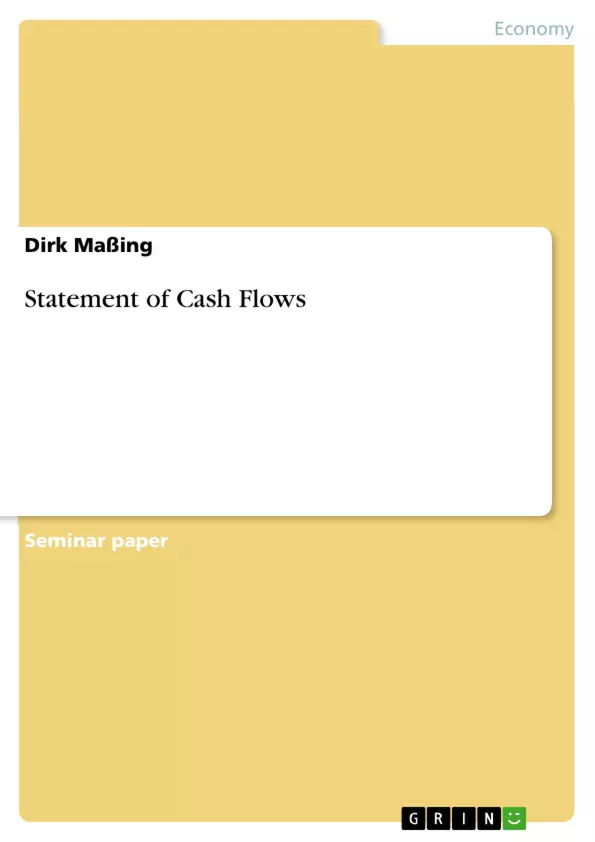This seminar paper will give an introduction to the statement of cash flows which is required as part of the financial statements of the US-GAAP. The statement facilitates the analysis of the liquidity, solvency, and financial flexibility of the firm. In german law a statement of cash flows was first introduced in 1998 by the KonTraG 1.2 In accordance with this law (resp. additions to existent law) german companies must publish such a statement when they are listed at the stock market.3 The mission and content of the statement in german law is not defined in German Commercial Code (HGB) but provided by the German Accounting Standards Committee (GASC) with German Accounting Standards No. 2 (GAS 2). It is drawn near IAS 7 of the International Accounting Standards and Statement of Financial Accounting Standards (SFAS) No. 95 of US-GAAP. The Security and Exchange Commission (SEC) sees cash flow statements of IAS 7 and SFAS No. 95 equally and excepts both.4 Because there are not many dierences between SFAS No. 95 and IAS 7 this paper just focuses on the US-GAAP.5
The statement of cash flows is structured in three sections. To set up the first section – called operating activities – you can choose either a direct or and indirect method. Both methods show the same investing and financing cash flows, and both show the reconciliation of net income and net operating cash flows. The main difference is that only the direct method shows the actual operating cash flows such as collections from customers and payments to suppliers. The indirect method uses the reconciliation as its operating activities section, that is why it is also called reconciliation method. When describing the content or giving examples of the statement the indirect method is used always in this paper. In spite of the fact that after SFAS No. 95 the Financial Accounting Standards Board (FASB) is preferring the direct method most companies are using the indirect method. This is because in most cases companies do not store all relevant data in their information system to use the direct method. In the other two sections – investing and financing activities – the direct method must be used.6
In the second part this work will give an overview and is showing details of form and content of the statement of cash flows according to the SFAS No 95, as well as it is presenting information about how to prepare the statement [...]
Inhaltsverzeichnis (Table of Contents)
- Introduction
- Statement of Cash Flows in US-GAAP
- Historical evolution
- Purposes
- Form and content
- Operating activities
- Investing activities
- Financing activities
- Notes
- Preparing a statement of cash flows
- Determine the positions of the statement
- Formulas
- Example
- Given information
- Preparing the statement
- Operating activities
- Investing activities
- Financing activities
- Conclusion
Zielsetzung und Themenschwerpunkte (Objectives and Key Themes)
This seminar paper aims to provide a comprehensive overview of the statement of cash flows within the framework of US-GAAP. It explores its historical evolution, purposes, structure, and preparation, emphasizing its role in evaluating a company's liquidity, solvency, and financial flexibility.
- Historical evolution and development of the Statement of Cash Flows
- Purpose and importance of the Statement of Cash Flows for financial analysis
- Structure and content of the Statement of Cash Flows, including operating, investing, and financing activities
- Methods for preparing and presenting the Statement of Cash Flows
- Application of the Statement of Cash Flows through a practical example
Zusammenfassung der Kapitel (Chapter Summaries)
- Introduction: The introduction sets the stage for the seminar paper by outlining the importance of the statement of cash flows, particularly within the context of US-GAAP. It highlights the statement's role in assessing a company's liquidity, solvency, and financial flexibility. The introduction also briefly discusses the statement's origins in German accounting standards and its connection to international accounting standards (IAS 7).
- Statement of Cash Flows in US-GAAP: This section delves into the statement of cash flows as it is defined and applied within the US-GAAP framework. It covers the historical evolution of cash flow reporting standards, from the early recommendations of the Accounting Principles Board (APB) to the current standards established by the Financial Accounting Standards Board (FASB). The section also explores the purposes of the statement of cash flows, emphasizing its role in providing insights into a company's ability to generate cash, meet obligations, and manage its financial resources.
- Example: This section provides a practical example of preparing a statement of cash flows. It presents a hypothetical company's financial data and guides readers through the process of classifying cash receipts and payments into operating, investing, and financing activities. The example aims to illustrate the practical application of the concepts discussed in the previous sections.
Schlüsselwörter (Keywords)
The key themes and concepts explored in this seminar paper include: Statement of Cash Flows, US-GAAP, Financial Accounting Standards Board (FASB), liquidity, solvency, financial flexibility, operating activities, investing activities, financing activities, direct method, indirect method, reconciliation method, historical evolution, purposes, form and content, preparation.
- Quote paper
- Dirk Maßing (Author), 2002, Statement of Cash Flows, Munich, GRIN Verlag, https://www.grin.com/document/10414



